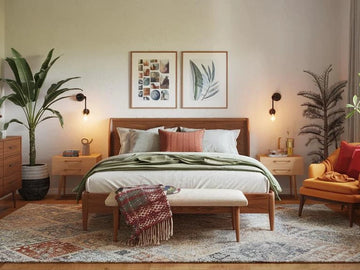Mixing wood tones helps us create an eclectic bedroom that feels warm and inviting. First, we choose a dominant wood tone, like warm oak or cool maple, to establish the room's mood. Then, we can mix up to three wood tones, using lighter woods for smaller pieces and darker woods for larger furniture to balance everything out. Don't forget to add textured fabrics to enhance the cozy vibe! Finally, well-chosen accent colors can tie in the wood tones beautifully. By following these tips, we can create a stylish space that truly reflects our personality—let's explore more ideas!
Key Takeaways
-
Choose a dominant wood tone for significant furniture pieces and complement it with up to two other wood tones for balance.
-
Stick to similar undertones when mixing wood tones to avoid clashes and create visual harmony.
-
Layer different textures and grains, such as light woods for smaller items and dark woods for larger ones, to enhance depth.
-
Incorporate cohesive accent colors that reflect your wood tone palette, repeating them in accessories for a unified look.
-
Explore design inspiration from online platforms and showrooms to discover diverse ideas for mixing wood tones in your bedroom.
Understanding Wood Tones
When we plunge into understanding wood tones, it's essential to recognize that they fall into two main categories: warm and cool. Warm tones, like oak and walnut, create a cozy feel, while cool tones, such as maple and ash, bring in a fresh vibe.
When we think about mixing different wood tones, we can craft a truly inviting space. It's important to remember that using two or three tones keeps things balanced. This avoids overwhelming the room and creates a lovely harmony.
Also, let's not forget how textiles can help bring these wood tones together. By choosing fabrics that complement our wood selections, we can create a warm and welcoming atmosphere that's perfect for everyone to enjoy.
Choosing a Dominant Tone
When we choose a dominant wood tone for our bedroom, it's important to look at the main pieces, like flooring or furniture.
Warm tones, such as oak and walnut, give a cozy feel, while cool tones like maple and ash can create a modern vibe.
Identifying Base Wood Tone
Often, we overlook the importance of identifying the base wood tone in our bedroom design. This tone, often found in flooring or major furniture, acts as our foundation. Recognizing this dominant wood tone helps tie everything together.
Here's how we can start:
-
Inspect the flooring: See if it's warm or cool.
-
Check cabinetry: Notice the wood type that stands out.
-
Examine large furniture: Look for consistent tones in pieces like beds or dressers.
-
Consider accessories: Identify smaller items that may add to the vibe.
Warm Vs. Cool Tones
Choosing the right dominant wood tone sets the stage for our bedroom's design, influencing the overall atmosphere we aim to create.
At Timbur, we recognize that warm wood tones, like oak and walnut, create a cozy and inviting feel. They make our spaces feel relaxing and comfortable—perfect for unwinding after a long day.
On the other hand, cool wood tones, like maple and ash, lend a sleek, modern vibe. This look suits minimalist designs well.
To mix wood tones effectively, we must guarantee they share the same undertones. Pairing warm woods with other warm tones prevents clashing.
Dominant Colors in Decor
In our quest for a beautifully designed bedroom, identifying a dominant color is essential as it guides every aspect of our decor, from furnishings to accessories.
The right wood tones set the mood and help us create a space that feels just right.
Here's how we can choose a dominant tone:
-
Start with a strong base: Choose our flooring or a large piece of wood furniture.
-
Pick the warmth: Decide if we want cozy oak or cool ash.
-
Keep it simple: Use additional shades that match the dominant tone.
-
Connect accents: Choose accessories that complement our wood tones.
Practical Mixing Techniques
When we're mixing wood tones in bedroom design, a few practical techniques can help us achieve a harmonious look.
First, let's choose a dominant wood tone for our main furniture pieces, like the bed or dresser. Then, we can gradually mix wood tones with smaller items, like picture frames or decorative bowls.
To keep things balanced, it's best to use no more than three different wood tones. Each tone should appear at least twice. For example, we can pair a wooden bed frame with nightstands that share a similar color.
Don't forget to take into account textures! Combining polished and rustic finishes adds depth.
Balancing Light and Dark Woods
How do we create a balanced mix of light and dark woods in our bedroom design? At Timbur, we believe it's all about harmony. When we blend these tones, we can make our spaces feel warm and inviting.
Here's how to do it:
-
Use light woods, like maple or birch, for smaller furniture pieces, enhancing openness.
-
Incorporate dark woods, like walnut or mahogany, in larger furniture, adding depth.
-
Match the wood's undertones—warm or cool—so everything complements each other.
-
Choose accessories like throw pillows or rugs that bring together both light and dark, creating a unified look.
Incorporating Textures and Grains
Creating a harmonious blend of light and dark woods paves the way for incorporating various textures and grains into our bedroom design.
At Timbur, we love mixing different wood grains for depth and interest. Pairing rustic finishes with smooth woods can really make a difference.
Textured woods, like reclaimed barn wood, bring warmth and coziness. They contrast beautifully with polished pieces, creating a dynamic look.
We can place different grain patterns strategically to unify our wood tones, enhancing the overall design.
Layering rugs with varied textures further amplifies the warmth of the wood.
Working With Accessories
When we think about accessories, it's key to choose pieces in wood tones that work well together.
We can layer textures too, like a cozy woven basket paired with a sleek wooden tray.
Plus, adding in some accent colors can really tie the whole look together and make our bedroom feel warm and inviting.
Choosing Complementary Wood Accessories
In designing a harmonious bedroom, we can enhance the overall aesthetic by thoughtfully choosing complementary wood accessories.
It's about creating a warm space where we feel at home.
Here are some ideas to get us started:
-
Nightstands: Use two different wood tones to balance the look.
-
Picture Frames: Mix sizes and shapes to showcase our memories.
-
Wooden Bowls: These can echo the main wood tone while adding interest.
-
Decorative Sculptures: Choose pieces that introduce smaller complementary hues.
Layering Textures for Depth
Texture is essential for crafting a warm and inviting bedroom, and layering various textiles can greatly enhance the space's depth. By using different materials, like rugs, pillows, and throws, we create a cozy contrast against wood tones.
We suggest mixing woven accessories, like cotton and linen, with smooth wood finishes. A chunky knit throw looks lovely on sleek furniture, adding dimension and warmth. Don't forget decorative baskets and wooden trays—they introduce new wood tones and help keep things tidy.
Here's a quick way to visualize our tips:
| Accessory | Texture Type | Purpose |
|---|---|---|
| Chunky Throw | Knitted | Contrast and warmth |
| Decorative Tray | Smooth wood | Style and function |
| Cotton Pillow | Soft fabric | Comfort |
| Woven Basket | Textured | Storage solution |
Mixing it all together can truly make your space feel like home.
Incorporating Accent Colors Strategically
Incorporating accent colors strategically not only adds vibrancy but also brings a unifying energy to our bedroom design.
By repeating these colors, we can enhance the beauty of our wood tones throughout the space.
Here's how we can do it:
-
Choose pillows that echo our accent colors for a cozy feel.
-
Add rugs featuring those colors to ground the room and tie elements together.
-
Select artwork that includes the same colors, creating visual interest.
-
Use decorative elements, like picture frames or vases, to highlight specific wood pieces.
With a thoughtful mix of accent colors and wood tones, our eclectic bedroom will feel cohesive and inviting.
Let's create a space that truly reflects who we are!
Color Coordination Strategies
Creating a harmonious bedroom design starts with a clear strategy for color coordination, especially when it comes to mixing wood tones. First, we should identify a dominant wood tone, like the flooring or a large piece of furniture. This choice will guide us in selecting complementary tones.
Incorporating up to three different types of wood tones maintains balance. It's crucial to repeat each tone at least twice in the room. Accent colors should also connect with our wood tones for unity.
Here's a quick reference table to help us visualize:
| Wood Tone | Accent Color |
|---|---|
| Warm Oak | Soft Cream |
| Cool Gray Pine | Deep Blue |
| Rich Walnut | Mustard Yellow |
Addressing Design Challenges
Mixing wood tones can present various design challenges, but we can navigate these issues successfully by keeping a few key points in mind.
Here are some tips to help us create a cozy bedroom:
-
Opt for medium wood hues to harmonize dark cabinets with lighter tones.
-
Soften any stark red undertones by using neutral or warm textures like bedding and curtains.
-
Layer decor elements, such as rugs or paint, to make laminate flooring feel cohesive.
-
Avoid mixing too many mismatched wood tones; consider sanding and re-staining pieces for a unified look.
Regularly reassessing our design choices is key.
Introducing black finishes can add contrast and interest among the wood tones, bringing our space to life.
Let's create a bedroom we love!
Sources of Inspiration
Finding inspiration for blending wood tones in our bedroom design can be an exciting journey. We can start by exploring online platforms like Instagram and Pinterest. These sites showcase different wood tone combinations and creative designs that spark our imagination.
Home decor blogs and design magazines give us expert tips and beautiful examples. Visiting showrooms allows us to see the textures and finishes of different wood materials up close. It helps us make informed choices.
Additionally, collaborations with brands like Loloi and Stuga offer affordable options for rugs and hardwood flooring, enhancing our space.
Ultimately, engaging with our community on social media and DIY forums allows us to share our experiences, inspiring one another to create something unique together.
Encouragement to Experiment
Exploring different wood tones can be intimidating, but it's a fantastic opportunity for us to express our personal style. At Timbur, we believe experimenting with wood tones can transform our bedrooms into unique spaces.
Let's not shy away from mixing!
Here are a few tips to get us started:
-
Choose two to three wood species for a balanced look.
-
Spread similar tones evenly to keep the space feeling calm.
-
Add accessories like picture frames or bowls in varied wood tones to experiment without big changes.
-
Combine warm and cool tones for rich variety and harmony.
Let's start small.
Gradually add new pieces and see how they blend with our existing decor. We'll create a space that truly feels like home!
Frequently Asked Questions
How Do You Mix Wood Tones in a Bedroom?
When we mix wood tones in our bedroom, we prioritize color harmony and texture balance. By selecting a dominant wood tone and thoughtfully integrating others, we create a welcoming and cohesive space that reflects our unique style.
What Wood Tones Go Well Together?
When we think about what wood tones go well together, we're drawn to combinations like warm oak and cool maple. Mixing these finishes creates beautiful complementary colors that bind our spaces together, making them feel inviting and cohesive.
Is It OK to Mix and Match Wood Tones?
Yes, it's totally okay to mix and match wood tones! By balancing wood tones and incorporating contrasting textures, we create warm, inviting spaces that reflect our unique style and foster a sense of belonging.
How Many Wood Tones Are in One Room?
When it comes to wood tones in a room, we recommend using no more than three. Finding wood tone compatibility and balancing contrast can create welcoming harmony, ensuring every space feels cohesive and inviting to everyone.
Conclusion
To sum up, mixing wood tones can truly elevate your bedroom design. By understanding different wood tones and experimenting with textures, you can create a unique space that reflects your style. Don't be afraid to play with light and dark woods, along with your favorite colors. With these tips, you're ready to design a cozy, eclectic bedroom that's all your own. At Timbur, we offer a variety of wood furniture pieces to help bring your vision to life—let's get started!









